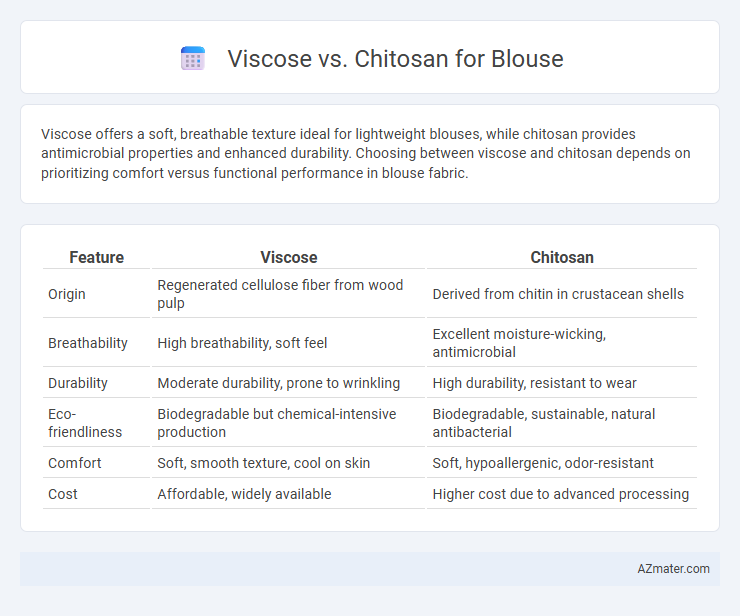Viscose offers a soft, breathable texture ideal for lightweight blouses, while chitosan provides antimicrobial properties and enhanced durability. Choosing between viscose and chitosan depends on prioritizing comfort versus functional performance in blouse fabric.
Table of Comparison
| Feature | Viscose | Chitosan |
|---|---|---|
| Origin | Regenerated cellulose fiber from wood pulp | Derived from chitin in crustacean shells |
| Breathability | High breathability, soft feel | Excellent moisture-wicking, antimicrobial |
| Durability | Moderate durability, prone to wrinkling | High durability, resistant to wear |
| Eco-friendliness | Biodegradable but chemical-intensive production | Biodegradable, sustainable, natural antibacterial |
| Comfort | Soft, smooth texture, cool on skin | Soft, hypoallergenic, odor-resistant |
| Cost | Affordable, widely available | Higher cost due to advanced processing |
Introduction to Viscose and Chitosan Fabrics
Viscose is a semi-synthetic fiber derived from cellulose, known for its silky texture, breathability, and drape, making it a popular choice for blouses. Chitosan fabric, produced from chitin found in crustacean shells, offers natural antimicrobial properties, biodegradability, and moisture-wicking abilities, ideal for active or sensitive skin wear. Both materials provide distinctive benefits in blouse manufacturing, combining comfort, sustainability, and style.
Origin and Production Processes
Viscose is a semi-synthetic fiber derived from cellulose extracted from wood pulp, undergoing chemical treatment and regeneration through a viscose process involving carbon disulfide and sodium hydroxide. Chitosan is a natural biopolymer obtained by deacetylation of chitin, primarily sourced from crustacean shells, employing enzymatic or alkaline chemical treatments. The production of viscose is industrial and resource-intensive with environmental concerns, while chitosan extraction emphasizes biodegradability and sustainable waste valorization.
Environmental Impact Comparison
Viscose production involves extensive use of water and chemicals, contributing to deforestation and pollution, while chitosan is derived from renewable chitin found in crustacean shells, offering a biodegradable alternative with minimal environmental harm. Manufacturing chitosan-based fabrics generates fewer greenhouse gases and waste compared to the viscose process, which relies heavily on energy-intensive treatments and toxic solvents. Choosing chitosan for blouses supports sustainable textile practices by reducing ecological footprint and promoting circular economy principles.
Breathability and Comfort Factors
Viscose fabric offers excellent breathability due to its natural cellulose fibers, making it lightweight and moisture-absorbent, ideal for blouses in warm climates. Chitosan, derived from chitin, provides antimicrobial properties and enhances skin comfort but tends to be less breathable compared to viscose. For optimal comfort, viscose blouses excel in airflow and moisture-wicking, while chitosan adds durability and odor resistance, impacting overall wearability.
Durability and Longevity
Viscose fabric offers a soft, breathable feel but tends to have lower durability and may weaken with repeated washing, reducing the blouse's longevity. In contrast, chitosan textiles, derived from natural biopolymers, provide enhanced strength and antimicrobial properties that contribute to longer-lasting fabric integrity and resistance to wear. Choosing chitosan for blouses ensures better durability and sustained quality over time compared to viscose materials.
Moisture Absorption and Skin Friendliness
Viscose fabric offers high moisture absorption due to its cellulose-based fibers, making it breathable and comfortable for blouses in warm climates. Chitosan, derived from chitin in shellfish, provides excellent skin friendliness with its natural antibacterial and hypoallergenic properties, reducing irritation and promoting healthy skin. Combining chitosan with viscose can enhance moisture-wicking capabilities while ensuring a soft, allergen-free blouse suitable for sensitive skin.
Dyeability and Color Retention
Viscose fabric exhibits excellent dyeability due to its high absorbency and porous structure, allowing vibrant and uniform color application on blouses. Chitosan, derived from natural biopolymers, offers superior color retention through its inherent antimicrobial properties that reduce color fading caused by microbial activity. Blouses made with chitosan-infused fabric maintain longer-lasting hues and resist discoloration better than traditional viscose materials.
Cost and Market Availability
Viscose is widely available and cost-effective, making it a popular choice for blouses in the fashion industry due to its affordability and ease of production. Chitosan, derived from crustacean shells, is more expensive and less commonly used in textiles, limiting its market availability for blouse manufacturing. The price difference and limited supply channels position viscose as the dominant fabric in terms of cost-efficiency and accessibility.
Suitability for Blouse Designs
Viscose offers a smooth, breathable texture ideal for elegant blouse designs that require fluid draping and vibrant color retention. Chitosan, derived from chitin, provides natural antimicrobial properties and moisture control, making it suitable for blouses aimed at enhanced comfort and durability. Suitability for blouse designs depends on desired aesthetics and functional benefits, with viscose favored for softness and appearance, while chitosan excels in performance and sustainability.
Conclusion: Choosing the Right Fabric for Your Blouse
Viscose offers a soft, breathable, and affordable fabric choice for blouses, known for its smooth texture and drape, making it ideal for everyday wear. Chitosan, derived from natural biopolymers, provides excellent antimicrobial properties and biodegradability, positioning it as a sustainable and functional option for eco-conscious consumers. Selecting the right fabric depends on the desired balance between comfort, aesthetics, sustainability, and specific performance features such as moisture management or antibacterial protection.

Infographic: Viscose vs Chitosan for Blouse
 azmater.com
azmater.com